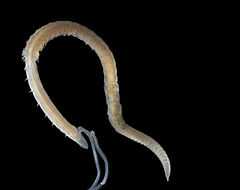Spionida
From Wikipedia, the free encyclopedia
| Spionida | |
|---|---|
 | |
| Magelona johnstoni with long feeding palps. | |
| Scientific classification | |
| Kingdom: | Animalia |
| Phylum: | Annelida |
| Class: | Polychaeta |
| Subclass: | Canalipalpata |
| Order: | Spionida |
| Families | |
|
Several, see text | |
Spionida is an order of marine polychaete worms in the subclass Canalipalpata. Spionids are cosmopolitan and live in soft substrates in the littoral or neritic zones.[1]
Characteristics
Spionids have a single pair of flexible feeding tentacles with grooves, arising directly from the prostomium. The mouth has no jaws and the pharynx is partly eversible. Some species have small eye spots and some a central sensory lobe. Some of the anterior segments paired gills. The parapodia or lateral lobes have large lamellae. The chaetae are unbranched capillaries, spines and hooks.[1][2]
Families
- Aberrantidae
- Apistobranchidae Mesnil and Caullery, 1898
- Chaetopteridae Audouin and Milne-Edwards, 1833
- Heterospionidae
- Longosomatidae Hartman, 1944
- Magelonidae
- Poecilochaetidae Hannerz, 1956
- Spionidae Grube, 1850
- Trochochaetidae Pettibone, 1963
- Uncispionidae Green, 1982 [3][4]
References
This article is issued from Wikipedia. The text is available under the Creative Commons Attribution/Share Alike; additional terms may apply for the media files.